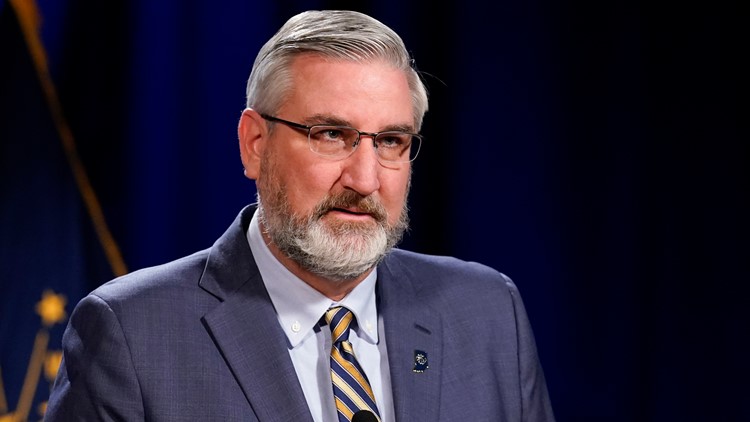INDIANAPOLIS — Quack, quack, quackery. Word on the street is that Eric Holcomb has suddenly become a "lame duck" governor. Earlier this month the IndyStar raised this notion despite the fact that he still has three and a half years left in his term, two biennial budgets to execute and one more to forge.
On the following day, Gov. Holcomb journeyed to Evansville where he announced the commitment of $475 million in funding dedicated to “three transformational infrastructure projects across southern Indiana” that will enhance Indiana’s top-rated transportation network as the Crossroads of America.
And six months prior, in the Howey Politics Indiana Power 50 edition published on Jan. 7, our analysis was this: “He is poised to become one of the most powerful governors in Indiana history. He won a second term in landslide fashion. He has consolidated education policy with his appointment of Katie Jenner as the state’s first education secretary. He has had the support of two super majority legislative chambers through the duration of this administration, with no end in sight. And he has been the lynchpin figure in dealing with the unprecedented COVID-19 pandemic.”
The gist of the Star’s premise that just six months into his second term he is a “lame duck” is centered on the notion that Holcomb had three vetos overridden by the GOP super majorities during an unprecedented pandemic, as well as Republican Attorney General Todd Rokita’s legal battle over the Indiana governor’s constitutional authority.
Indiana Republican Chairman Kyle Hupfer was incredulous that the question was even asked. “No. One, he’s the best known, most popular politician in the state of Indiana," Hupfer said. " It’s not even close. That alone prevents him from being some sort of a lame duck.
“Second, we just had a session which is apparently the basis of this article where the governor got every single legislative priority he set forth at the beginning,” Hupfer said. “He got even more, every funding goal, moving forward on his teacher pay commission report, several billions of dollars extra to spend on infrastructure, which he’ll do over the course of the next three and a half years, a huge pay-down in debt which was his approach, $500 million in READI grants which were his initiative to jump start regional growth which he’s been talking about since he came into office.”
The Star appeared to take the three veto overrides as a sign of weakness, when everyone at the Statehouse knows that the 1851 Constitution purposefully created a weak governorship in order to preserve legislative power. A governor’s veto can be overridden by a simple majority instead of the two-thirds needed to overcome a presidential veto.
Despite this showdown, there doesn’t appear to be any sustained acrimony among Holcomb, House Speaker Todd Huston and Senate President Pro Tem Rodric Bray.
This extended era of Republican super majorities is distorting the true prowess of Gov. Holcomb. “It has, to some degree, but there still was a same page. They were all on the same page on 99 and a half percent of all bills. I don’t know if the super majorities have changed things on how people think. There’s still a significant number who are all on the same page.”
Hupfer added that most legislative Republicans used Holcomb in their election materials: “During the 2020 primary and general elections, every one of them were throwing the governor on their (mailing) piece.” And, Hupfer observed, Gov. Holcomb spent the fall of 2019 campaigning for Republican mayoral candidates throughout the state, helping to forge a record 71 victories that year.
There have only been five governors (Doc Bowen, Robert Orr, Evan Bayh, Frank O’Bannon and Mitch Daniels) who have served two consecutive terms. Most of their key legislative triumphs came during their first terms, which may fuel the notion that reelected governors are like new cars, losing significant value immediately after winning that second election.
But Gov. Orr achieved his A+ education reforms during his fourth biennial budget term in 1987. And in 2011, Gov. Daniels forged sprawling education reforms three years after winning a second term and a year after Republicans regained the House majority.
None of these governors had super majorities. Bowen had to deal with a Democratic super majority after the 1974 GOP washout following President Nixon’s Watergate scandal. O’Bannon and Daniels had to grapple with deep recessions during their second terms.
Gov. Holcomb will have during his fifth and sixth years at the helm a record amount of funds – measured in the billions of dollars – to spread across the state. And he has two years of power beyond that.
His Regional Economic Acceleration and Development Initiative (READI), described on the Indiana Economic Development Corporation website as “a bold, transformational initiative that will dedicate $500 million in state appropriations to promote strategic investments that will make Indiana a magnet for talent and economic growth” will give Holcomb numerous opportunities to lavish record amounts of money in every sector of the state.
Lame ducks don’t have funds to spread around or future budgets to forge. There is no Democrat playing at Holcomb’s level.
If you’re a state legislator, county commissioner or mayor, treat Holcomb as a “lame duck” at your own risk.
The columnist is publisher of Howey Politics Indiana at www.howeypolitics.com. Find Howey on Facebook and Twitter @hwypol.



